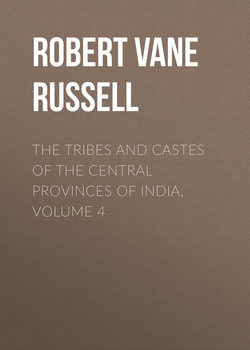Читать книгу The Tribes and Castes of the Central Provinces of India, Volume 4 - Robert Vane Russell - Страница 16
Part II
Articles on Castes and Tribes
Kumhār—Yemkala
Vol. IV
Kunbi
3. Subcastes
ОглавлениеThe internal structure of the Kunbi caste in the Central Provinces shows that it is a mixed occupational body recruited from different classes of the population. The Jhāre or jungly17 Kunbis are the oldest immigrants and have no doubt an admixture of Gond blood. They do not break their earthen vessels after a death in the house. With them may be classed the Mānwa Kunbis of the Nāgpur District; these appear to be a group recruited from the Mānas, a primitive tribe who were dominant in Chānda perhaps even before the advent of the Gonds. The Mānwa Kunbi women wear their cloths drawn up so as to expose the thigh like the Gonds, and have some other primitive practices. They do not employ Brāhmans at their marriages, but consult a Mahār Mohtūria or soothsayer to fix the date of the ceremony. Other Kunbis will not eat with the Mānwas, and the latter retaliate in the usual manner by refusing to accept food from them; and say that they are superior to other Kunbis because they always use brass vessels for cooking and not earthen ones. Among the other subcastes in the Central Provinces are the Khaire, who take their name from the khaīr18 or catechu tree, presumably because they formerly prepared catechu; this is a regular occupation of the forest tribes, with whom it may be supposed that the Khaire have some affinity. The Dhanoje are those who took to the occupation of tending dhan19 or small stock, and they are probably an offshoot of the Dhangar or shepherd caste whose name is similarly derived. Like the Dhangar women they wear cocoanut-shell bangles, and the Mānwa Kunbis also do this; these bangles are not broken when a child is born, and hence the Dhanojes and Mānwas are looked down on by the other subcastes, who refuse to remove their leaf-plates after a feast. The name of the Khedule subcaste may be derived from kheda a village, while another version given by Mr. Kitts20 is that it signifies ‘A beardless youth.’ The highest subcaste in the Central Provinces are the Tirole or Tilole, who now claim to be Rājpūts. They say that their ancestors came from Therol in Rājputāna, and, taking to agriculture, gradually became merged with the Kunbis. Another more probable derivation of the name is from the til or sesamum plant. The families who held the hereditary office of Deshmukh, which conferred a considerable local position, were usually members of the Tirole subcaste, and they have now developed into a sort of aristocratic branch of the caste, and marry among themselves when matches can be arranged. They do not allow the remarriage of widows nor permit their women to accompany the wedding procession. The Wāndhekars are another group which also includes some Deshmukh families, and ranks next to the Tiroles in position. Mr. Kitts records a large number of subcastes in Berār.21 Among them are some groups from northern India, as the Hindustāni, Pardesi, Dholewār, Jaiswār and Singrore; these are probably Kurmis who have settled in Berār and become amalgamated with the Kunbis. Similarly the Tailanges and Munurwārs appear to be an offshoot of the great Kāpu caste of cultivators in the Telugu country. The Wanjāri subcaste is a fairly large one and almost certainly represents a branch of the Banjāra caste of carriers, who have taken to agriculture and been promoted into the Kunbi community. The Lonhāre take their name from Lonār Mehkar, the well-known bitter lake of the Buldāna District, whose salt they may formerly have refined. The Ghātole are those who dwelt above the ghāts or passes of the Saihadri range to the south of the Berār plain. The Baone are an important subcaste both in Berār and the Central Provinces, and take their name from the phrase Bāwan Berār,22 a term applied to the province by the Mughals because it paid fifty-two lakhs of revenue, as against only eight lakhs realised from the adjoining Jhādi or hill country in the Central Provinces. In Chhindwāra is found a small local subcaste called Gādhao because they formerly kept donkeys, though they no longer do so; they are looked down on by the others who will not even take water from their hands. In Nimār is a group of Gujarāti Kunbis who are considered to have been originally Gūjars.23 Their local subdivisions are Leve and Karwa and many of them are also known as Dālia, because they made the dāl or pulse of Burhānpur, which had a great reputation under native rule. It is said that it was formerly despatched daily to Sindhia’s kitchen.
17
From jihār, a tree or shrub.
18
Acacia catechu.
19
Dhan properly means wealth, cf. the two meanings of the word stock in English.
20
Berār Census Report (1881), para. 180.
21
Ibidem.
22
Bāwan = fifty-two.
23
Bombay Gazetteer, Hindus of Gujarāt p. 490, App. B, Gūjar.
